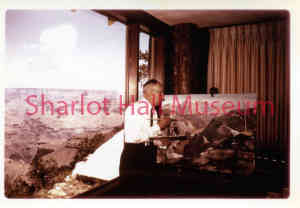Emery Clifford Kolb
details
Unknown Unknown po0123pd.jpg PO-0123 Color 1700-0123-0004 po0123pd Print 4x5 Historic Photographs August 10, 1963 Reproduction requires permission. Digital images property of SHM Library & ArchivesDescription
Emery Clifford Kolb (b. February 15, 1881 - d. December 11, 1976) and his older brother, Ellsworth Leonardson Kolb (b. January 4, 1876 - d. January 9, 1960), were born in Smithfield, Pennsylvania and became famous explorers and photographers in Arizona. Ellsworth came to the Grand Canyon in 1901 and persuaded his brother to join him in 1902.
On his journey west, Emery bought a photographic store in Williams while waiting for his train ride to the Grand Canyon. In 1903 the brothers moved their business to the Grand Canyon, first camping in a tent on the rim of the canyon. In 1904 they built Kolb Studio, a small wooden house on the Bright Angel Trail. They sold books of their extensive photos of the Grand Canyon and in 1911 began making films, including of their navigation of the Green and Colorado Rivers. Emery made the first low-level airplane flight into the canyon. Both are buried in the Grand Canyon Pioneer Cemetery.
Purchase
To purchase this image please click on the NOTIFY US button and we will contact you with details
The process for online purchase of usage rights to this digital image is under development. To order this image, CLICK HERE to send an email request for details. Refer to the ‘Usage Terms & Conditions’ page for specific information. A signed “Permission for Use” contract must be completed and returned. Written permission from Sharlot Hall Museum is required to publish, display, or reproduce in any form whatsoever, including all types of electronic media including, but not limited to online sources, websites, Facebook Twitter, or eBooks. Digital files of images, text, sound or audio/visual recordings, or moving images remain the property of Sharlot Hall Museum, and may not be copied, modified, redistributed, resold nor deposited with another institution. Sharlot Hall Museum reserves the right to refuse reproduction of any of its materials, and to impose such conditions as it may deem appropriate. For certain scenarios, the price for personal usage of the digital content is minimal; CLICK HERE to download the specific form for personal usage. For additional information, contact the Museum Library & Archives at 928-445-3122 ext. 14 or email: orderdesk@sharlot.org.




